Disclaimer
Jean Honore Fragonard
French Rococo Painter, Draftsman & Landscapist
1732 - 1806
Self Portrait of Jean-Honore Fragonard
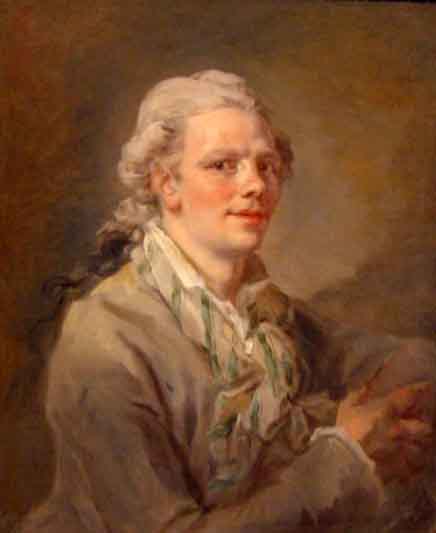
Jean-Honore Fragonard was a French painter and printmaker whose late Rococo manner was distinguished by remarkable facility, exuberance, and hedonism. One of the most prolific artists active in the last decades of the Ancien Regime, Fragonard produced more than 550 paintings (not counting drawings and etchings), of which only five are dated. Among his most popular works are genre paintings conveying an atmosphere of intimacy and veiled eroticism.
He was born at Grasse, Alpes-Maritimes, the son of a glover. He was apprenticed to a Paris notary when his father's circumstances became strained through unsuccessful speculations, but showed such talent and inclination for art that he was taken at the age of eighteen to Francois Boucher, who, recognizing the youth's rare gifts but disinclined to waste his time with one so inexperienced, sent him to Chardin's atelier. Fragonard studied for six months under the great luminist, then returned more fully equipped to Boucher, whose style he soon acquired so completely that the master entrusted him with the execution of replicas of his paintings.
Though a pupil of the Academy, Fragonard gained the Prix de Rome in 1752 with a painting of "Jeroboam Sacrificing to the Golden Calf", but before proceeding to Rome he continued to study for three years under Charles-Andre van Loo. In the year preceding his departure he painted the "Christ washing the Feet of the Apostles" now at Grasse Cathedral. On September 17, 1756, he took up his abode at the French Academy in Rome, then presided over by Charles-Joseph Natoire.
Jeroboam Sacrificing to the Golden Calf: 1752

While at Rome, Fragonard contracted a friendship with a fellow painter, Hubert Robert. In 1760, they toured Italy together, executing numerous sketches of local scenery. It was in these romantic gardens, with their fountains, grottos, temples and terraces, that Fragonard conceived the dreams which he was subsequently to render in his art. He also learned to admire the masters of the Dutch and Flemish schools (Rubens, Hals, Rembrandt, Ruisdael), imitating their loose and vigorous brushstrokes. Added to this influence was the deep impression made upon his mind by the florid sumptuousness of Giovanni Battista Tiepolo, whose works he had an opportunity to study in Venice before he returned to Paris in 1761.
In 1765 his "Coresus et Callirhoe" secured his admission to the Academy. It was made the subject of a pompous (though not wholly serious) eulogy by Diderot, and was bought by the king, who had it reproduced at the Gobelins factory. Hitherto Fragonard had hesitated between religious, classic and other subjects; but now the demand of the wealthy art patrons of Louis XV's pleasure-loving and licentious court turned him definitely towards those scenes of love and voluptuousness with which his name will ever be associated, and which are only made acceptable by the tender beauty of his color and the virtuosity of his facile brushwork; such works include the Serment d'amour (Love Vow), Le Verrou (The Bolt), La Culbute (The Tumble), La Chemise enlevée (The Shirt Removed), and L'oscillation (The Swing, Wallace Collection), and his decorations for the apartments of Mme du Barry and the dancer Madeleine Guimard.
Coresus Sacrificing Himself to Save Callirhoe: 1765
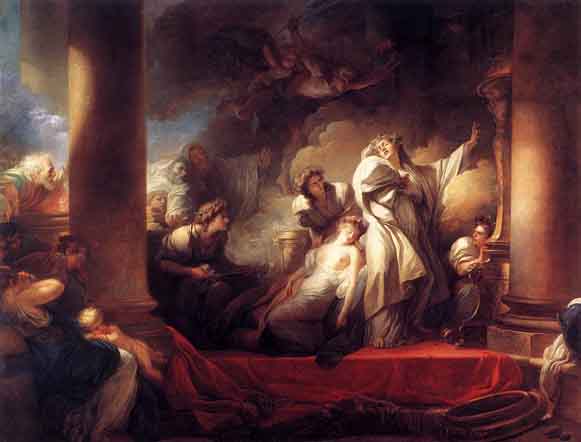
When Fragonard tackled the history picture - a rare occasion - it, like his other paintings, was animated by love. The large Coresus sacrificing himself to save Callirhoé, shown at the Salon of 1765, is Fragonard's effort to combine his own tendencies with academic requirements. It is not surprising that he exhibited there only once afterwards; this sort of machine was replaced by brilliant, witty decorations, positive riots of cupids and bathers, kissing lips and torn clothes, which always express love in action. The Coresus is negative love, sublime self-sacrifice, and in effect useless passion. Fragonard docs his best to excite the composition, sending waves of smoky clouds and excited winged figures to fill the space between the two pillars not occupied by the strangely feminine priest and the swooning heroine - herself almost as if ravished by love. Perhaps hints from Boucher and Tiepolo worked on Fragonard to emulate the high style for which he was not suited. His genius lay in aiming lower, from an academic standpoint, in being more rational and natural - that is, by being wittier, mischievous, and relaxed.
The Vow to Love: ca 1780
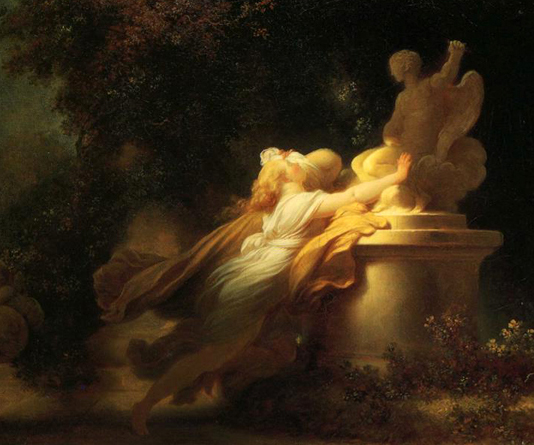
The Bolt: ca 1778
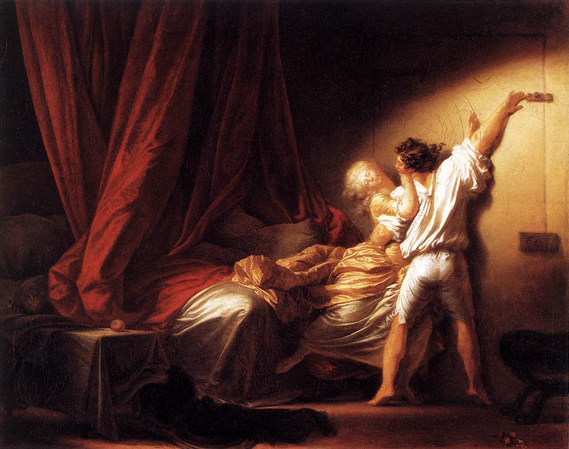
La Culbute (The Tumble)1766
1766.jpg)
La-Chemise-Enlevee
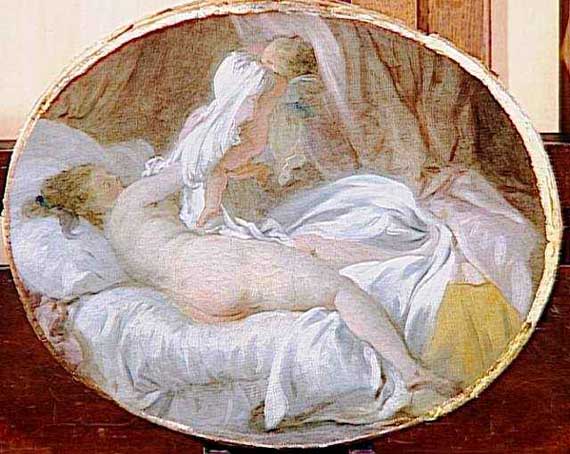
The Swing: 1767
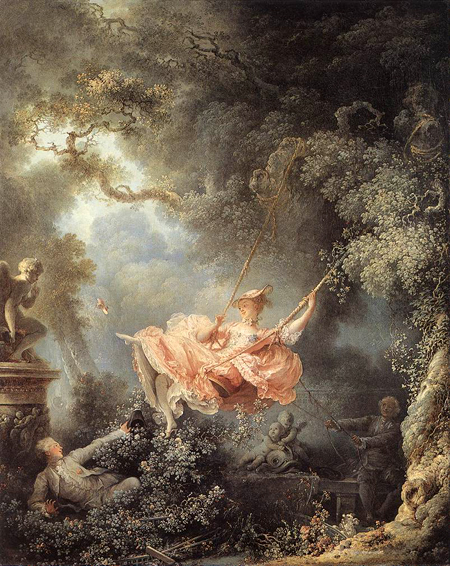
The Swing (1767) is his most famous painting. Housed at the Wallace Collection, it displayed the dreamy, idyllic fantasies of the royal court. "Apres moi, le deluge," said Louis XIV. This blissful, childish existence crashed down around Fragonard because it was economically unsustainable and savagely tyrannical. In this painting, we see the worldview of the French aristocracy, beautiful and deluded. So though we admire the graceful loveliness of Fragonard's world (or that of his clients), it is a bittersweet thought, touched by an awareness of the social implications of the subject matter.
A lukewarm response to these series of ambitious works induced Fragonard to abandon Rococo and to experiment with Neoclassicism. He had married in 1769 and had a daughter, Rosalie Fragonard (1769-1788), who became one of his favorite models. In October 1773 he again went to Italy with Pierre-Jacques Onézyme Bergeret de Grancourt and his son, Pierre-Jacques Bergeret de Grancourt. In September 1774, he returned through Vienna, Prague, Dresden, Frankfurt and Strasbourg.
Back in Paris, the artist fell in love with Marguerite Gérard, his wife's 14-year-old sister who became his pupil and assistant in 1778. In 1780, he had a son, Alexandre-Evariste Fragonard (1780-1850), who eventually became a talented painter and sculptor. The French Revolution deprived Fragonard of his private patrons: they were either guillotined or exiled. The neglected painter deemed it prudent to leave Paris in 1793 and found shelter in the house of his friend Maubert at Grasse, which he decorated with the series of decorative panels known as the Les progres de l'amour dans le cour d'une jeune fille, originally painted for Chateau du Barry.
The Progress of Love - The Pursuit: 1773
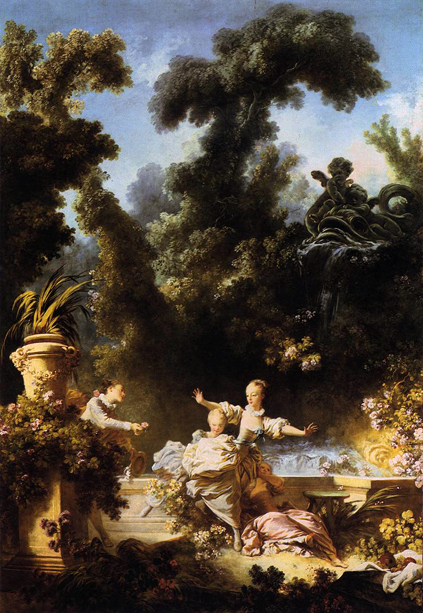
The Progress of Love - The Meeting: 1773

The Progress of Love - The Lover Crowned

He returned to Paris early in the nineteenth century, where he died in 1806, almost completely forgotten.
For half a century or more he was so completely ignored that Lubke in his History of Art (1873) omits the very mention of his name. Subsequent reevaluation has confirmed his position among the all-time masters of French painting. The influence of Fragonard's handling of local color and expressive, confident brushstroke on the Impressionists (particularly his grand niece, Berthe Morisot, and Renoir) cannot be overestimated.
A Boy as Pierrot: 1776-80
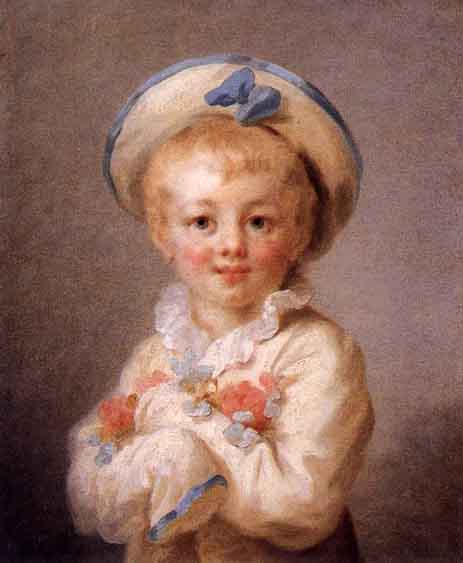
The fanciful composition imitates several miniatures which have been attributed to Fragonard, whose wife exhibited a number of miniatures of children between 1779 and 1782.
A Game of Horse and Rider: 1767-73
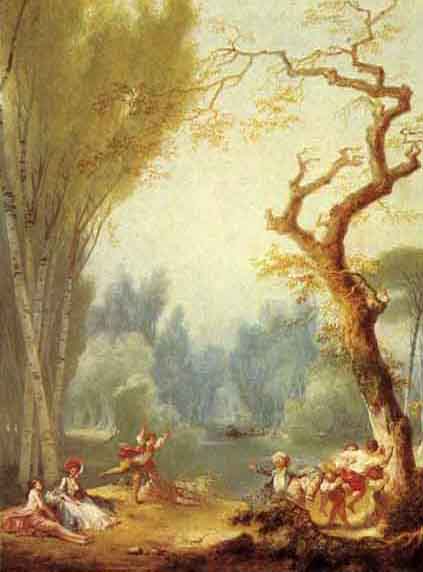
A Young Girl Reading: ca 1776
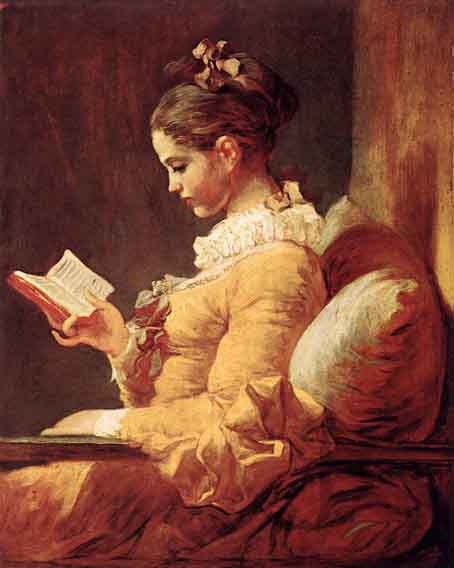
In A Young Girl Reading (1776), Fragonard displayed Dutch influences that entered his work in the '70's. An increasing admiration of the works of Rembrandt impacted his draping and anatomy. This work reflects a popularization of domestic scenes during the era.
Like the Impressionists of a century later, Fragonard's brushwork is indistinct, rather than meticulous and exact. This painting features a soft vagueness foreign to Academic painting, and yet is more precise. Although this is an idealized portrait, it is not fantastic, like the Edenic paintings of royal court life.
A Young Scholar: 1775-78
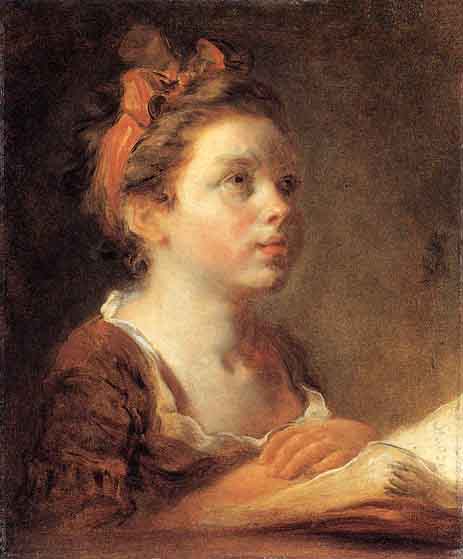
Abbe de Saint Non
(Fanciful Figure): 1769
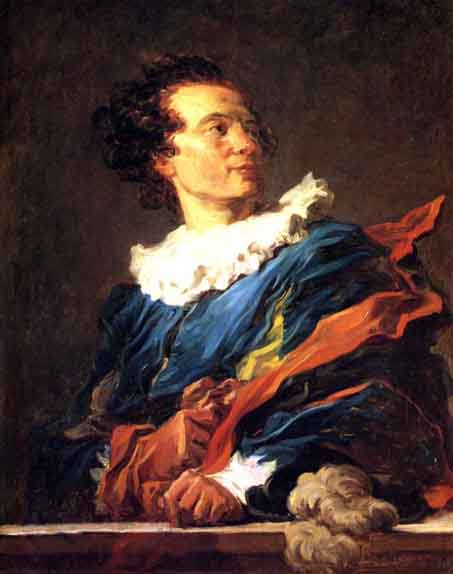
In 1769, Fragonard painted fourteen "fanciful figures" eight of which are now in the Louvre. These spirited portraits, whether painted from life or invented, with highly colored faces and broad strokes of red and gold, represent the vision of an inspired poet capturing the essence of his subject.
Abbe de Saint-Non was Fragonard's rich patron, who pushed him toward the Academy.
Adoration of the Shepherds: ca 1775
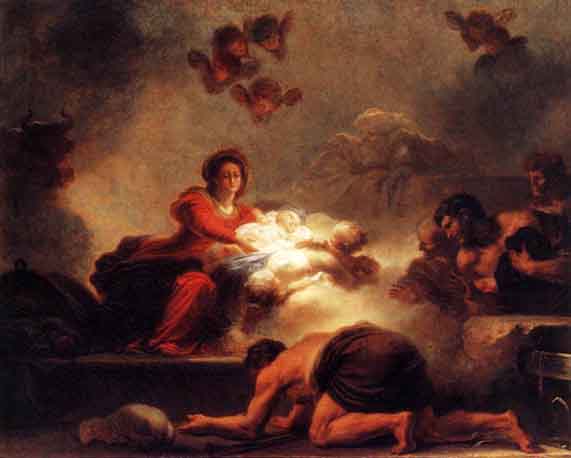
Avenue of Trees: ca 1762-63

Barrel Organist: 1780's
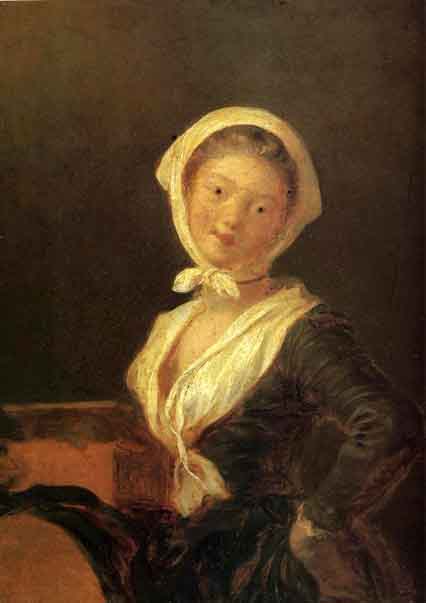
Benjamin Franklin: ca 1778
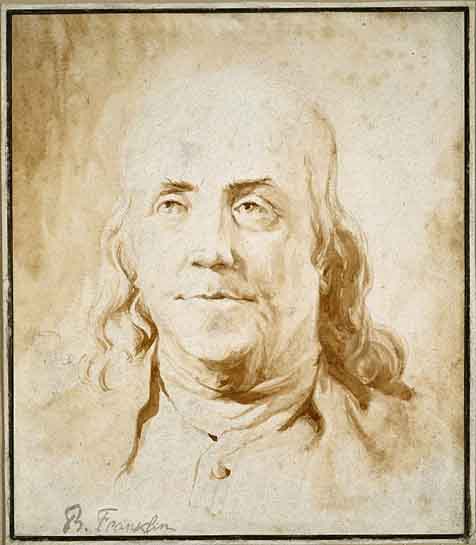
Blindman's Bluff: ca 1750-52
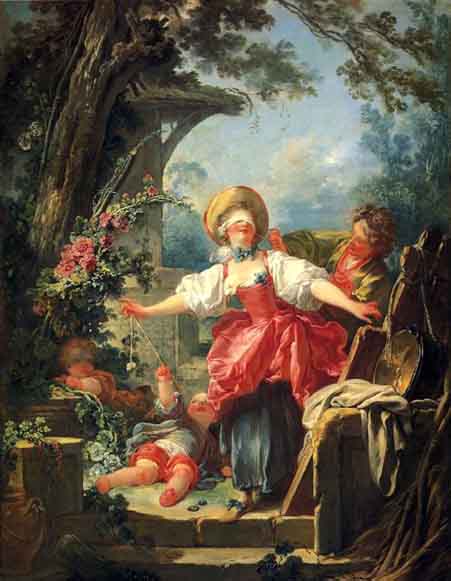
Confession of Love
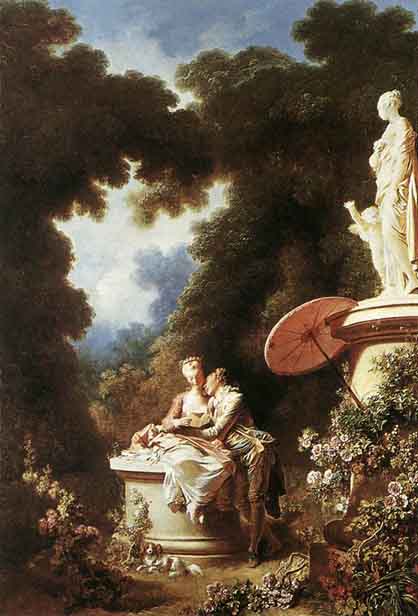
Here is The Confession of Love (1771), owned by the Frick Collection. The dog, a Papillon, is the symbol of the French monarchy.
We see echoes of Adam and Eve in the Garden. They have no worries or concern; only love for each other. The romantic ambiance of this painting reminds one of the light-headed exuberance of dating a beautiful woman. Such is the ecstasy of young love.
Fontaine d'amour: ca 1785
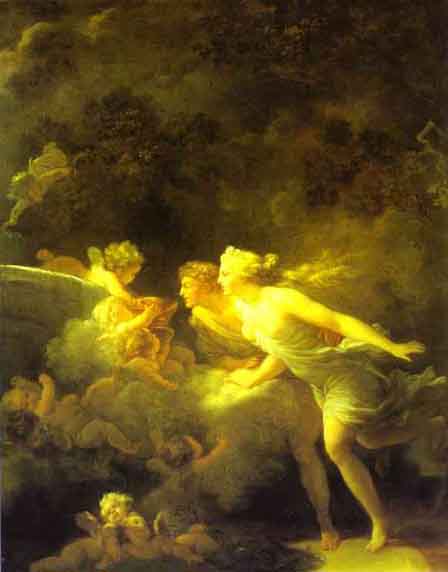
In the midst of a verdant forest, a young man and woman eagerly rush forward, their feet just reaching the edge of a fountain's basin. Putti frolic in the fountain's waters and billowing spray, and one of them offers a cup of the magical liquid for the young lovers to drink. The story of the 'Garden of Love', an allegory of the nature and progress of love that has its origins in the poetry of classical antiquity and the Middle Ages, centers on this 'Fountain of Love'. The fountain brings forth the water in which Cupid dips his arrows or from which lovers drink and fall in love. In nearly every period, artists have painted this romantic motif. During the 1700's, artists came to treat the 'Fountain of Love' almost as a genre subject, with lovers in contemporary dress flirting in a garden around a decorative fountain. With this version, Jean-Honore Fragonard returned the allegory to its classical origins and imbued it with the thrilling rush of those first beguiling moments of love. The quintessential Rococo artist, Fragonard responded to the Neoclassical movement in an extremely inventive manner, adding a soft, steamy atmosphere to his cameo-like figures.
Forsaken or Reverie: 1790-91
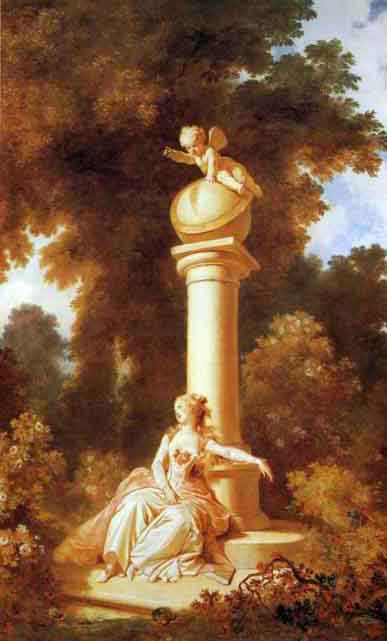
Two Sisters

The earliest description we have of the picture is from a 1785 sale catalog, where it is described as "two girls occupied with games suitable to their ages." The younger child is seated upon a hobby horse; the older pushes the horse, while holding its peach-colored lead rein. The painting, which has been cut down, dates to about 1770.
The identity of the sisters is unknown. Until recently, they have been called the artist's daughter Rosalie (born 1769) and his sister-in-law Marguerite Gerard (born 1761). This is unlikely given the known difference in age between the two.
Vieillard
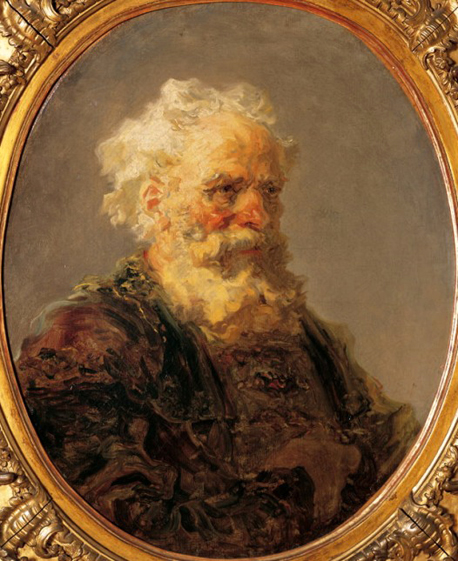
Girl Making a Dog Dance on Her Bed: Late 1760's
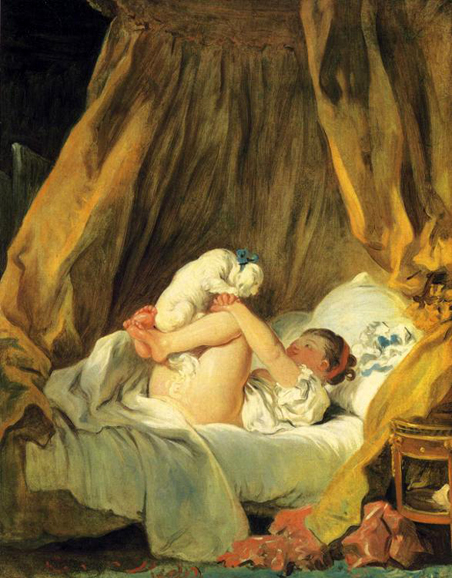
Groups of Children in the Sky
(A Swarm of Cupids): ca 1765-67
_ ca_ 1765_67.jpg)
Head of a Young Man

Inspiration: ca 1769

La Fete a Saint Cloud
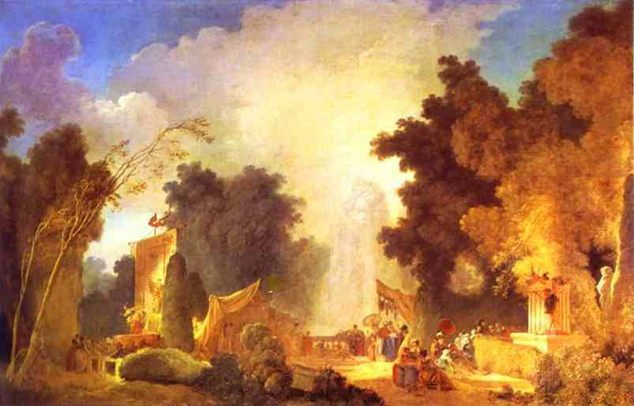
Le petit parc: 1764-65
_ca_1761_62.jpg)
Fragonard used light and atmosphere to absorb people and objects until one is left with an airy, empty but still vibrating, surface; it is as if a conjuring trick had been played over some painting by Boucher, from which so much 'reality' has been abstracted. For both Fragonard and the Guardi, this is an escape from the discipline represented by Boucher and Tiepolo, but it is given an additional twist by Fragonard's knowledge and admiration of Tiepolo - the wilder genius anyway, but one become wilder and more romantic in Fragonard's interpretations of his compositions. Just as Veronese had provided Tiepolo with material out of which to build his own fantasy, so Tiepolo stimulated Fragonard.
Fragonard is a Romantic Rococo painter, inspired more perhaps by the picturesque aspects of nature than by people, who are usually dwarfed into insignificance beside the foaming trees which shoot up like great jets in his landscapes. When this Francesco Guardi-like diminution does not take place, Fragonard seems to produce a version of Gian Antonio's style, in which figures become mere arabesques of paint, animated but often faceless, tight balls of energy that shoot about the canvas under the impulse of his brush. In both styles they remain the painter's puppets, and one is always conscious of manipulation. Although capable of doing so, he is really too eager to stop and record natural appearances, actual textures, or facial expressions.
This charming parkscape is composed from drawings made in the gardens of the Villa d'Este in Tivoli in 1760.
Mademoiselle Guimard: ca 1768

Marie Madeleine Guimard
(Fanciful Figure): 1769
_1769.jpg)
In 1769, Fragonard painted fourteen "fanciful figures" eight of which are now in the Louvre. These spirited portraits, whether painted from life or invented, with highly colored faces and broad strokes of red and gold, represent the vision of an inspired poet capturing the essence of his subject, whether it is Diderot's ardent features or Mademoiselle Guimard's pleasing, if irregular face and arched bust in a burgundy bodice. Here Fragonard can be compared to Frans Hals or Rembrandt, because his artistic initiatives were nourished by an unusual degree of cultivation.
Mademoiselle Guimard was a dancer.
Match to Powerkeg
(Le feu aux poudres): 1763-64
_1763_64.jpg)
Fragonard had begun producing erotica after his first Italian sojourn. His light, casual, yet confident handling can be seen in such works as Le feu aux poudres. They celebrate an adolescent pleasure, a rare ensemble in which the thrill of desire is exalted without the least trace of vulgarity.
Music Lesson: 1769
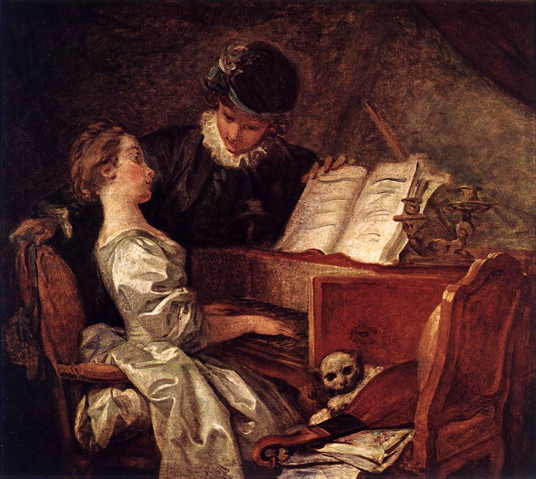
Some critics assume that this painting is a study for a larger composition.
Portrait de Fantasie Monsieur de la Breteche
(Fanciful Figure): 1769
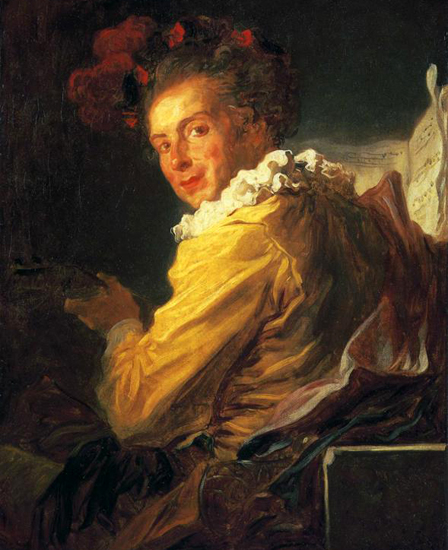
In 1769, Fragonard painted fourteen "fanciful figures" eight of which are now in the Louvre. These spirited portraits, whether painted from life or invented, with highly colored faces and broad strokes of red and gold, represent the vision of an inspired poet capturing the essence of his subject.
The painting belongs to a subset of the Fanciful Figures, representing Music, Poetry, Song and Comedy.
Monsieur de la Breteche was the brother of Abbe de Saint-Non, Fragonard's patron.
Portrait of a Girl
(Study of Song): ca 1769
_ca_1769.jpg)
Portrait of a Horseman
(Saint Non in Spanish Costume): ca 1769
_ca_1769.jpg)
Portrait of a Young Man
(The Actor): ca 1769
_ca_1769.jpg)
Portrait of Diderot
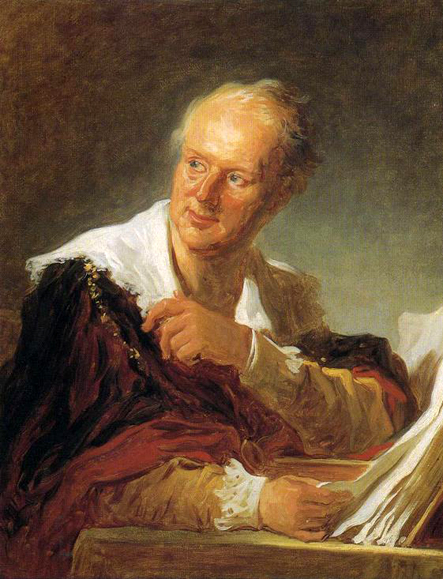
Denis Diderot was a French philosopher and writer during the Age of Enlightenment, best known for being the coauthor of the Encyclopedie. He was born in the city of Langres in 1713 and studied at the Lycee Louis le Grand. In 1732 he earned a Master of Arts degree in philosophy and decided to study law instead of joining the clergy. However, two years hence he changed his mind again and decided to become a writer, for what he was disowned by his father and spent the next ten years living a somewhat vagabond way of life.
In 1743 he married Antoinette Champion, even though the match was considered inappropriate because of her low social and fatherless status, poor education and lack of a dowry. The couple had only one surviving child, Angelique, named after Diderot's mother and late sister.
Diderot did not receive much fame or money during his life despite his arduous work and was even forced to sell his library to provide his daughter with a dowry. Catherine II of Russia then bought the library and requested that Diderot keep the books in Paris until she required them and work as her librarian for a yearly salary.
Diderot died in 1784 in Paris. He was buried in the city's Eglise Saint-Roch.
Portrait of a Man
(The Warrior): ca 1769
_ca_1769.jpg)
Psyche Showing her Sisters her Gifts from Cupid: 1753
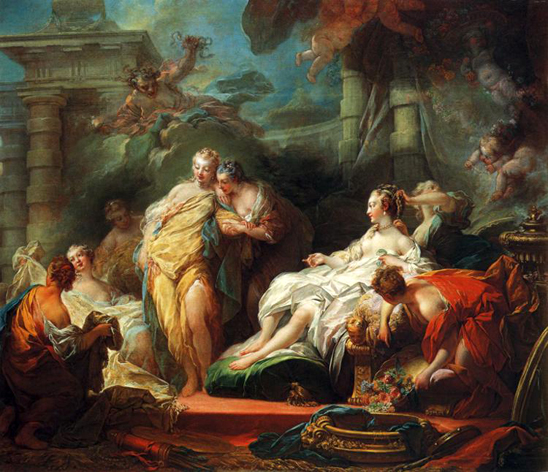
A prize-winning pupil of Francois Boucher, Fragonard in this youthful picture, painted at the Ecole des Eleves Proteges in Paris, seems a perfect exponent of the taste of Boucher's patrons King Louis XV and his mistress the Marquise de Pompadour. However, after an unsuccessful final bid for institutional recognition at the Paris Salon exhibition of 1767, Fragonard virtually disappeared from official artistic life under the monarchy, working almost entirely for private patrons, many of them his friends. He was thus able to give free rein to a more individualistic celebration of nature, instinct and impulse. Whether in oils, gouache, pastels, in engravings and etchings, or in his many drawings in chalk, pen or wash, he came to efface the distinctions between sketch and finished work, and even between the boundaries of the genres. We cannot always tell, for example, whether any one of his many pictures of single figures is a portrait in fancy dress, or imaginary.
On his two visits to Italy, the first to the French Academy in Rome (1756-61), and the second over a decade later as the guest of a patron, Fragonard was drawn to the landscape and to contemporary and near-contemporary Italian artists, notably Tiepolo and Giordano. He was unmoved either by ancient ruins or by Renaissance art. With the collapse of the art market during the French Revolution he retired to his native Grasse in Southern France, but was drawn into politics by his son's teacher, the painter David. His late paintings show him trying to conform, not always successfully, to the Neo-classical austerity of David's 'republican' style.
The subject here is drawn from the allegorical tale of Cupid and Psyche by the Latin poet Apuleius, probably in a French version by La Fontaine. Psyche is showing off her 'storehouses of treasure' to her sisters in the magical castle in which she has been installed by Cupid, god of love. The sisters 'conceived great envy' - personified here by the serpent-haired figure of Eris, goddess of discord, hovering above - and try to wreck her happiness by destroying her faith in her invisible lover. In its handling of paint, and in such details as the chubby flying babies - the putti of ancient art, who here represent the castle's invisible servants - the picture, painted when the artist was barely 21, betrays the influence of Rubens's works at the Luxembourg Palace and also of Watteau.
The composition is derived from a tapestry design for the same subject by Boucher. But the colors, with harmonies of gold and orange beginning to replace Boucher's accords of rose and blue, are already recognizably Fragonard's own. They appear in their purest and most concentrated form in the flowers at the foot of Psyche's throne, the area of the painting most clearly 'in focus'. Definition diminishes towards the edges of the picture, as it might in a convex mirror, and with it the colors tend to lose their identity, to mix and mingle, framing the main figures in shades of grey or darkened tones, presaging the disasters to come.
Rinaldo in the Enchanted Forest: 1764.
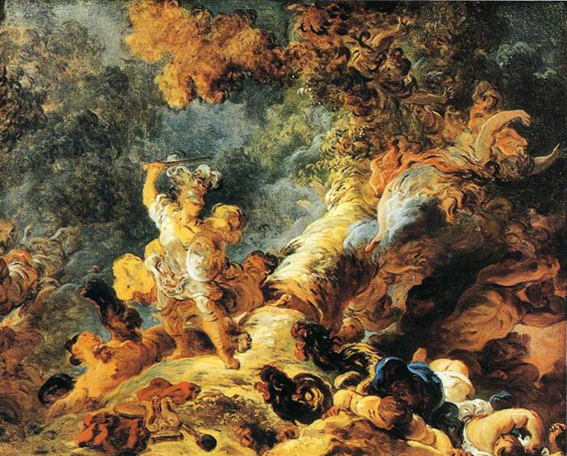
Tasso, Torquato (1544-95), Italian poet, author of a romantic epic Rinaldo (1562), a pastoral play very popular in his time, Aminta (1573); the epic poem Jerusalem Delivered (150-81) about the first crusade. The subjects from his works were used by the artists.
Armida in Tasso's Jerusalem Delivered, is a powerful enchantress. She offered her service to the defenders of Jerusalem when it was besieged by the Christians under Godfrey de Bouillon; visiting the Christian camp she lured away by her beauty many of the principal knights. She inveigled them by magic power into a delicious garden, where they were overcome by apathy and pleasant half dream. Among her captives were Renaud (or Rinaldo) of Este and Tancred.
Rinaldo in the Gardens of Armida: 1764
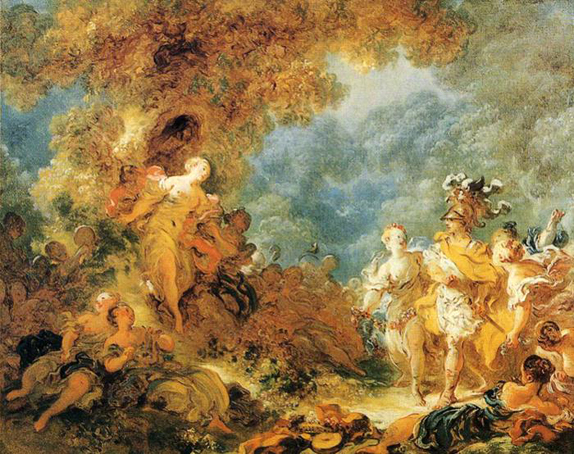
Self Portrait: ca 1760

The Armoire: 1778
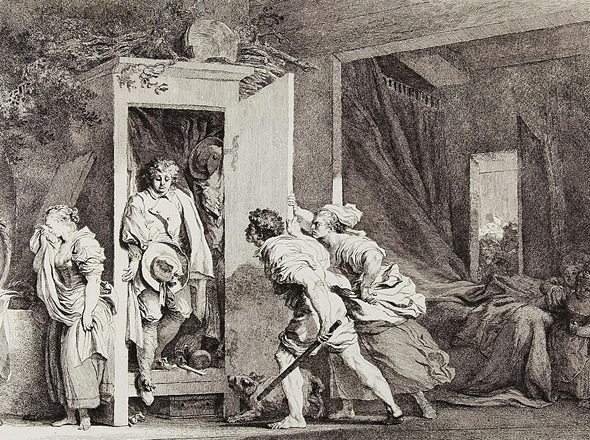
The Bathers: 1772-75

The Cradle: 1761-65
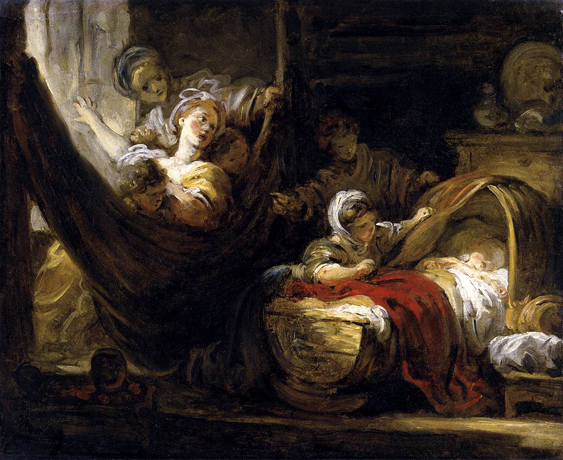
This painting shows the strong influence of Rembrandt, especially that of Rembrandt's Holy Family which in the 18th century was in Paris and Fragonard made a copy of it.
The Cradle of the Happy Family
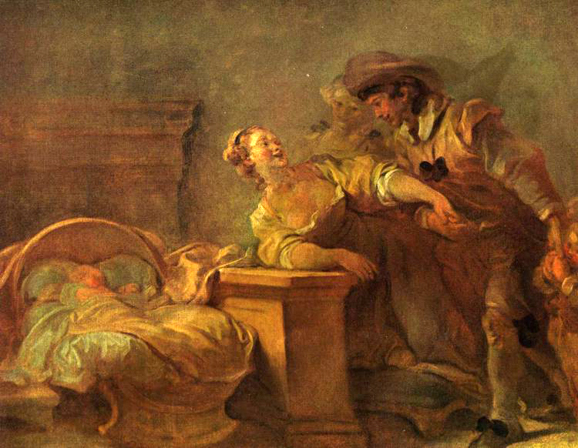
The Education of the Virgin: Late 1770's
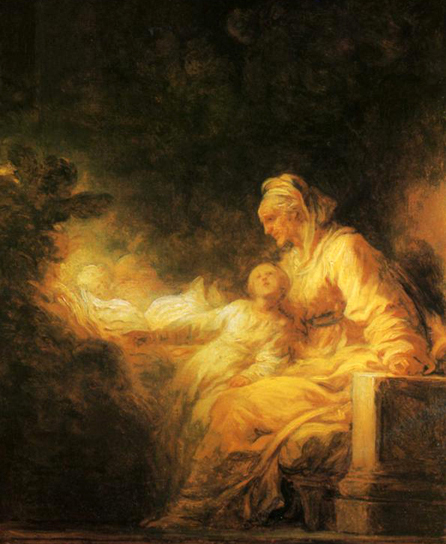
The Entrance to the Fountain of Pomona
Known as Fontanone at the Villa d'Este in Tivoli: 1760

The Fair at Saint Cloud: ca 1775-78
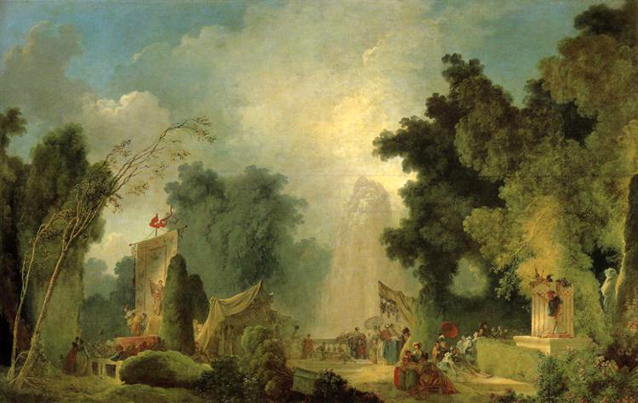
The Farmer's Children

The Grand Cascade at Tivoli: 1760

The Happy Family: 1769
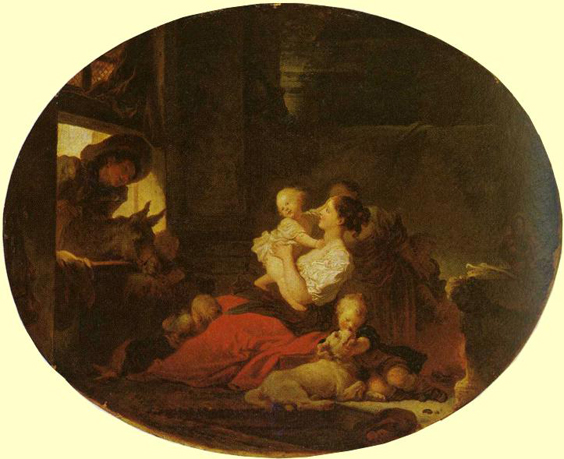
The Isle of Love also called
La Fete a Rambouillet: 1770's
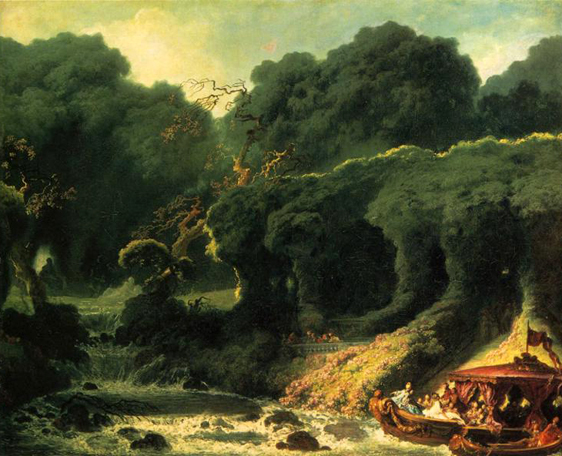
The Italian Family: ca 1759
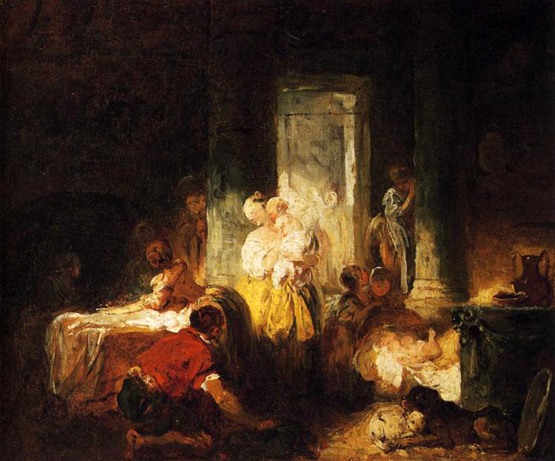
The Letter
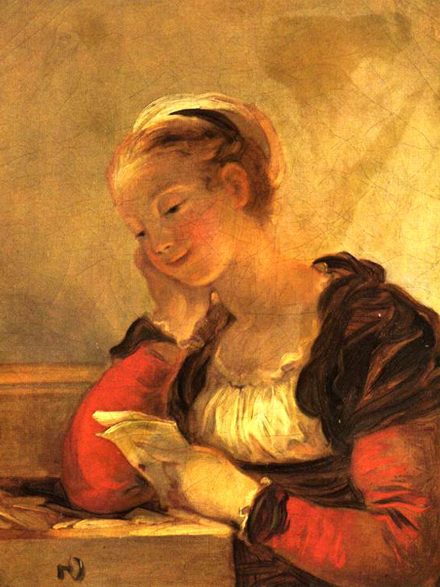
The Little Swing: 1770's
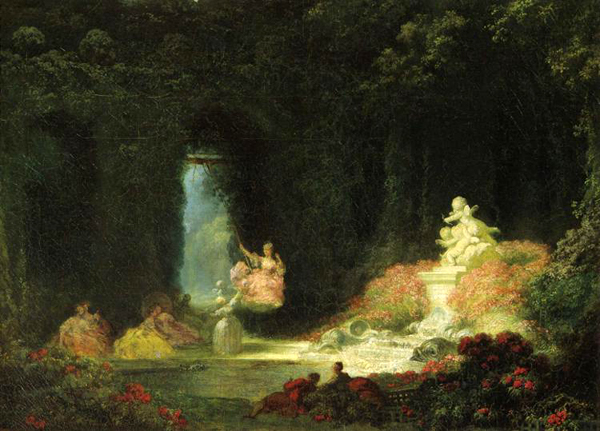
The Lost Wager: ca 1759
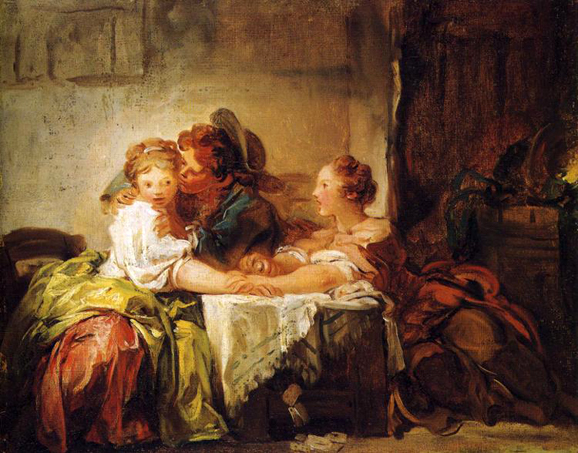
The Love Letter: 1770's
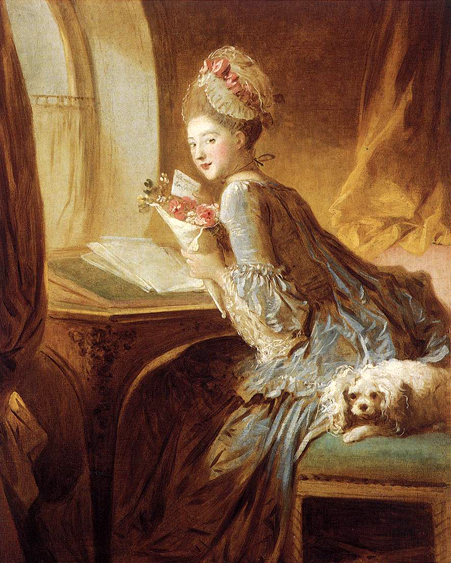
This picture exemplifies Fragonard's feeling for color, his sensitive handling of effects of light, and his extraordinary technical facility. The elegant blue dress, lace cap, and coiffure of the woman seated at her writing table must have been the height of fashion at the time this painting was made. The inscription on the letter she holds has given rise to different interpretations. It may simply refer to her cavalier, but if it is read Cuvillere, then the sitter would be the daughter of Francois Boucher, Fragonard's teacher. Marie Emilie Boucher, born in 1740, was widowed in 1769 and married, in 1773, her father's friend, the architect Charles Etienne Gabriel Cuvillier.
The Musical Contest: ca 1754
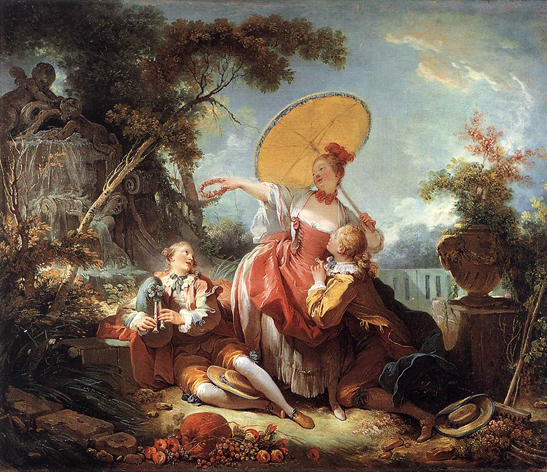
Additions made to this canvas, probably in the late 18th century, were turned over in 1987 to reveal this engaging composition by the young Fragonard working in Boucher's idiom.
The New Model: 1760's
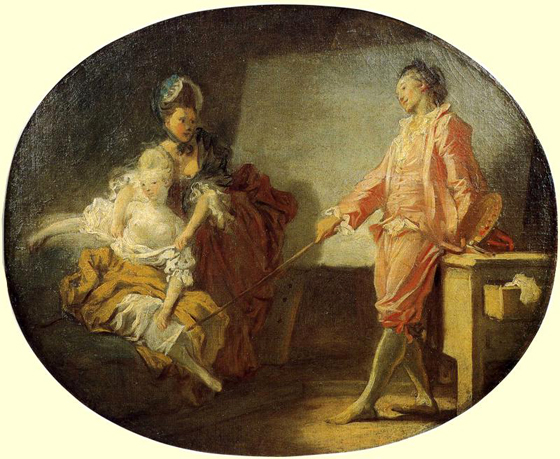
The Schoolmistress
(Now Say Please): 1770's
_1770_s.jpg)
The Souvenir: 1775-78
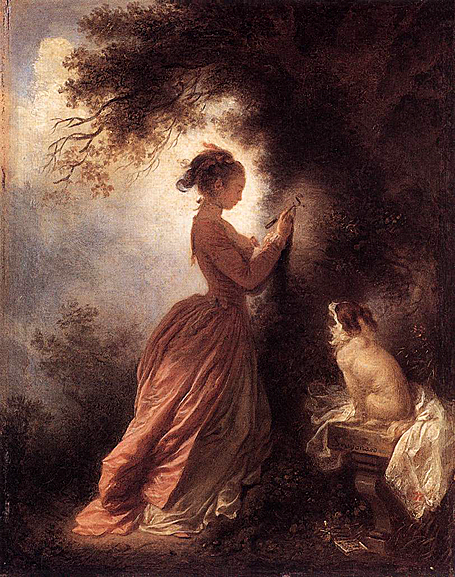
The girl carves in the tree the initials of her lover, whose letter lies on the ground.
The Stolen Kiss: 1787-89
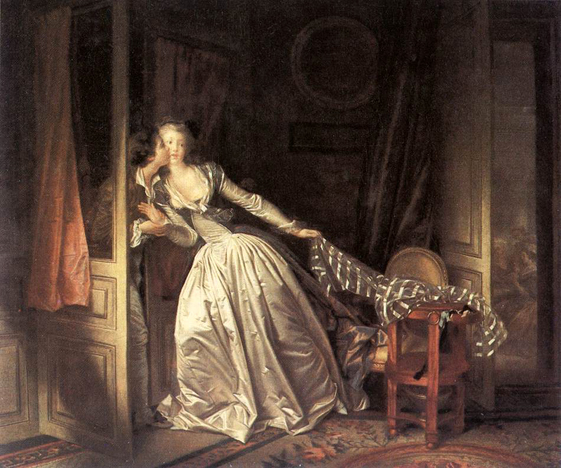
Fragonard may have executed this copy himself, for it shows his delicate coloring and spontaneous brushwork which gives the picture an irresistible verve and joyfulness. As always with Fragonard, more important than the subject matter are the soft tones and colors of the palate.
What do these aspects say about the self-conscious image of French aristocrats on the eve of the revolution? Can this picture be analyzed in terms of the mores of contemporary French society? It may be but probably goes far beyond the 18th Century and also reflects an innocence of our own society.
The Storm or The Cart Stuck in the Mire: 1759
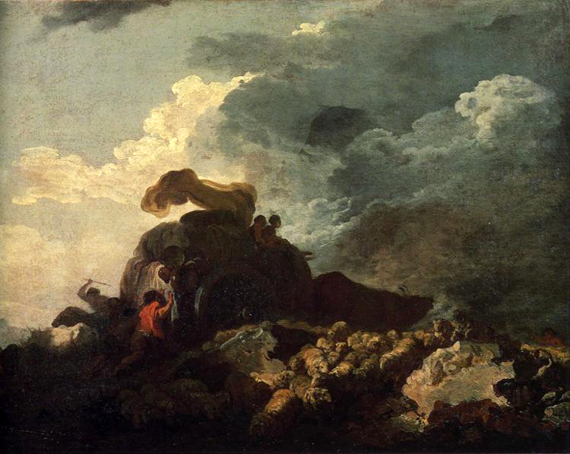
The Swing - Probably: 1765
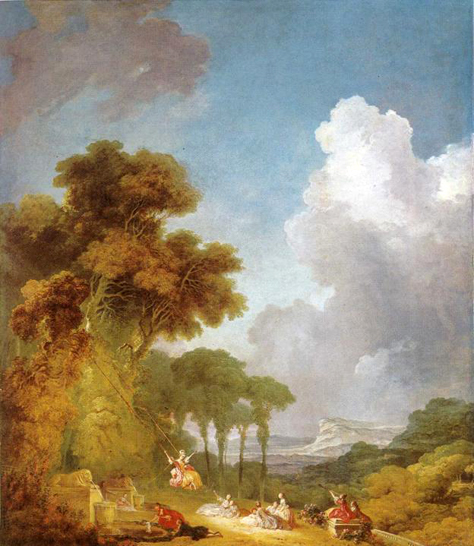
The Toilet of Venus: Late - 1760's

The Useless Resistance: ca 1764-68
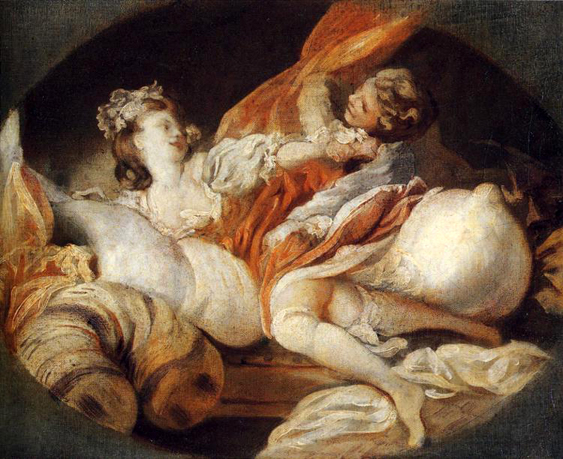
The Visit to the Nursery: Before 1784

The Watering Place: ca 1762-64
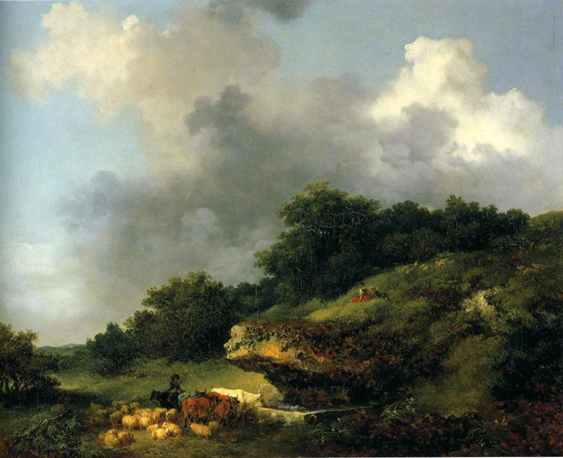
The White Bull
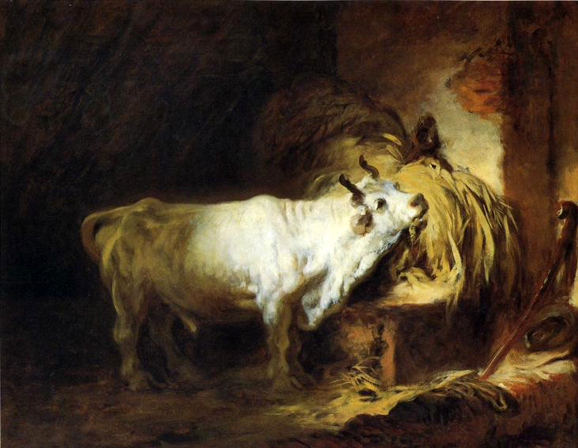
Venus and Cupid: ca 1760
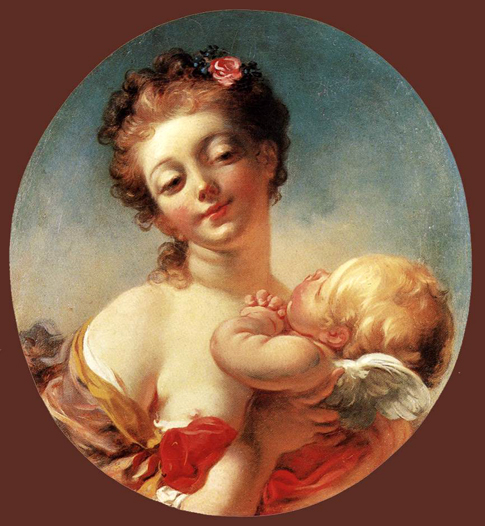
Washerwomen: ca 1758-61

Winter: ca 1753-56
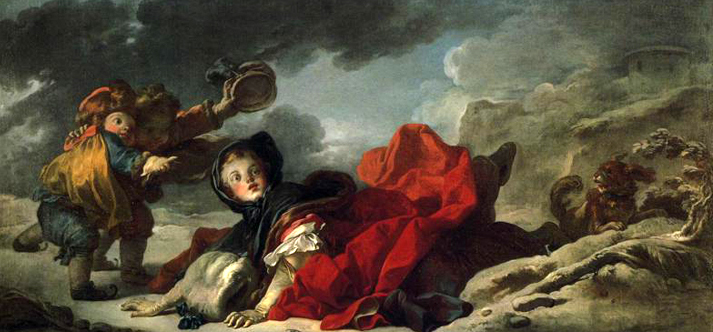
Young Woman Holding Up Her Child: ca 1750-52
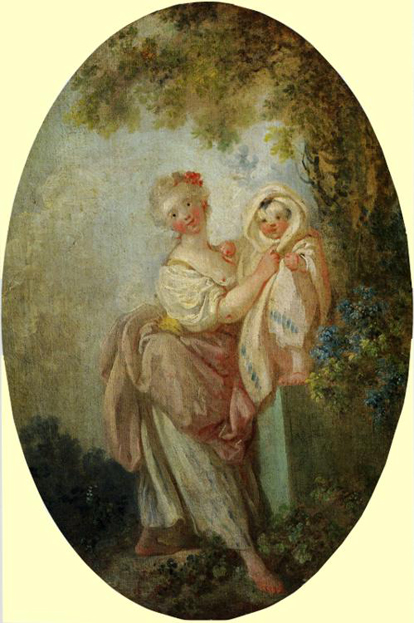
Young Woman Playing with a Dog: 1765-72
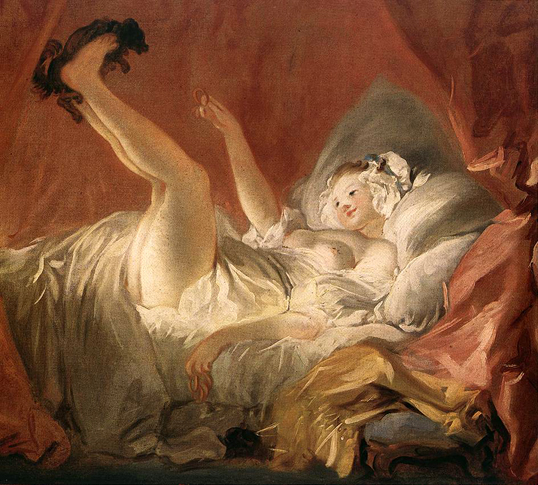
Young Woman Standing: 1775-85
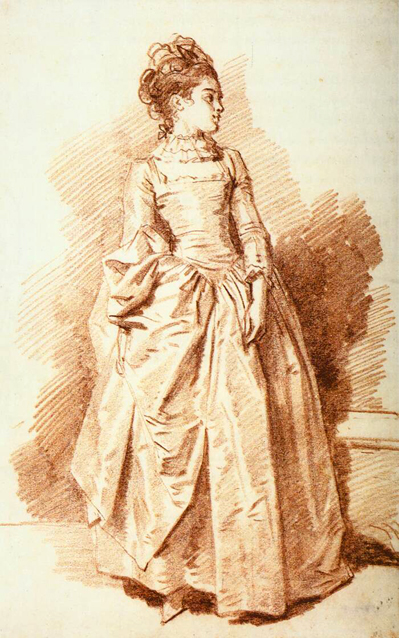
Opinions differ as to the identity of this young woman, who is shown elegantly gathering up her skirts. It could be Fragonard's sister-in-law and pupil Marguerite Gérard or, as is nowadays believed, his daughter Rosalie. Fragonard took full advantage of his material, chalk, using a variety of contours, planes and shading to produce a charming portrait. His rendering of the satin material and the facial expression is particularly masterly.
Source: Art Renewal Center
Source: WebMuseum: Jean-Honore Fragonard
This page is the work of Senex Magister
Return to Pagina Artis
Return to Bruce and Bobbie's Main Page.






1766.jpg)





















_ ca_ 1765_67.jpg)



_ca_1761_62.jpg)

_1769.jpg)
_1763_64.jpg)


_ca_1769.jpg)
_ca_1769.jpg)
_ca_1769.jpg)

_ca_1769.jpg)






















_1770_s.jpg)














